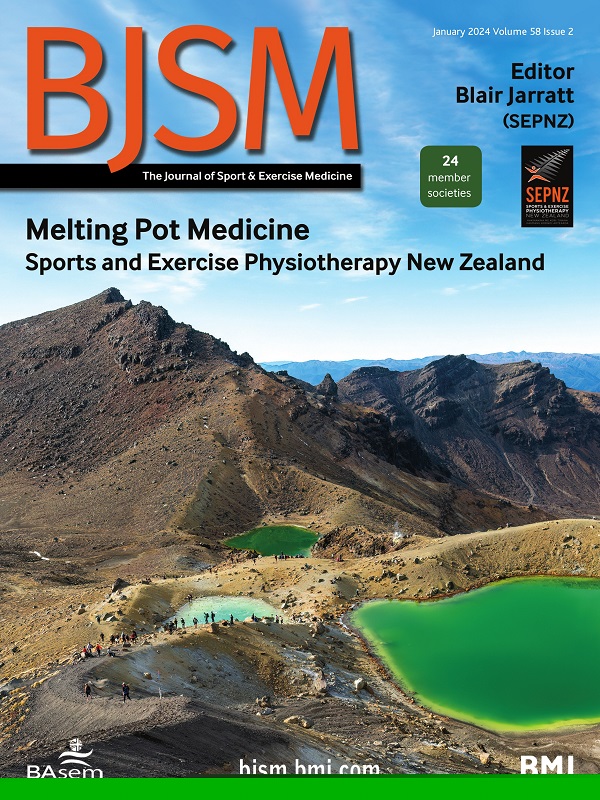Considerations for a women's rehabilitation programme following anterior cruciate ligament reconstruction: a concept mapping approach to enhance women's outcomes.
IF 16.2
1区 医学
Q1 SPORT SCIENCES
引用次数: 0
Abstract
OBJECTIVE To identify gender/sex-specific considerations to enhance anterior cruciate ligament (ACL) rupture rehabilitation experiences and outcomes among women. METHODS Mixed-methods concept mapping. 19 women 1-3 years post-ACL rupture and 28 rehabilitation practitioners (68% physiotherapists) who regularly treat women following ACL rupture brainstormed statements to a prompt ('What factors should be addressed in ACL rehabilitation for women (18-45 years)?') before thematically sorting and rating the statements for importance and feasibility (5-point Likert scales). RESULTS Ninety unique statements were brainstormed, sorted and rated. A seven-cluster solution was identified-from most to least important (number of statements, cluster mean importance/5)-1. foster goal-driven rehabilitation (18, 3.98); 2. promote mental and emotional well-being (13, 3.96); 3. create adaptable and supportive environments (10, 3.74); 4. provide education and resources (16, 3.73); 5. engage the whole team for the whole woman (13, 3.52); 6. address accessibility and competing demands (8, 3.36) and 7. build peer, group and social support (12, 3.22). 'Goal-driven rehabilitation' was deemed the most, and 'peer, group and social support' the least feasible cluster to address in women-specific ACL rehabilitation. CONCLUSION Enhancing ACL rehabilitation strategies could reduce the gender/sex disparity for women most at risk of inferior short- and long-term outcomes. Practitioners can leverage our seven-cluster solution for practical guidance in creating supportive and empowering environments that prioritise collaboration and active listening, enabling women-centred goal-driven rehabilitation practices. Lower-rated clusters, such as peer, group and social support, may remain crucial, as they reflect known influences on rehabilitation motivation and adherence.前交叉韧带重建后妇女康复方案的考虑:一种提高妇女预后的概念映射方法。
目的确定性别/性别特异性考虑因素,以提高女性前交叉韧带(ACL)断裂康复的经验和结果。方法混合方法概念映射。19名前交叉韧带破裂后1-3年的女性和28名前交叉韧带破裂后定期治疗女性的康复从业人员(68%为物理治疗师)对提示进行了头脑风暴陈述(“18-45岁女性前交叉韧带康复应注意哪些因素?”)’),然后对陈述进行主题排序和重要性和可行性评级(5分李克特量表)。结果对90条独特陈述进行了头脑风暴、分类和评分。从最重要到最不重要(语句数,集群平均重要性/5)-1,确定了7个集群的解决方案。培养目标驱动型康复(18,3.98);2. 促进精神和情感健康(13,3.96);3. 创造适应性强和支持性的环境(10,3.74);4. 提供教育和资源(16,3.73);5. 让整个团队为整个女人服务(13,3.52);6. 解决可及性和竞争性需求(8,3.36)和7。建立同伴、团体和社会支持(12,3.22)。在女性ACL康复中,“目标驱动型康复”被认为是最可行的,而“同伴、团体和社会支持”是最不可行的。结论加强前交叉韧带康复策略可以减少女性短期和长期预后不良风险的性别差异。从业者可以利用我们的七个集群解决方案,在创造支持性和赋权环境方面提供实践指导,这些环境优先考虑合作和积极倾听,从而实现以女性为中心的目标驱动的康复实践。评分较低的类别,如同伴、团体和社会支持,可能仍然至关重要,因为它们反映了对康复动机和坚持的已知影响。
本文章由计算机程序翻译,如有差异,请以英文原文为准。
求助全文
约1分钟内获得全文
求助全文
来源期刊
CiteScore
27.10
自引率
4.90%
发文量
217
审稿时长
3-8 weeks
期刊介绍:
The British Journal of Sports Medicine (BJSM) is a dynamic platform that presents groundbreaking research, thought-provoking reviews, and meaningful discussions on sport and exercise medicine. Our focus encompasses various clinically-relevant aspects such as physiotherapy, physical therapy, and rehabilitation. With an aim to foster innovation, education, and knowledge translation, we strive to bridge the gap between research and practical implementation in the field. Our multi-media approach, including web, print, video, and audio resources, along with our active presence on social media, connects a global community of healthcare professionals dedicated to treating active individuals.

 求助内容:
求助内容: 应助结果提醒方式:
应助结果提醒方式:


